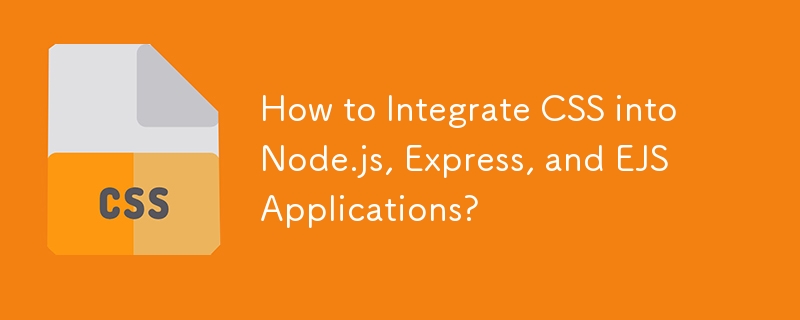How to Integrate CSS into Node.js, Express, and EJS Applications?

Styling with CSS: Integration with Node, Express, and EJS
When navigating through the intricate realms of web development, seamlessly integrating CSS into your Node, Express, and EJS applications can prove challenging. This comprehensive guide will unravel the enigma, enabling you to effortlessly don your web pages with the aesthetic charm of CSS.
The Path to Style Enlightenment
To establish a harmonious connection between your Express application and the captivating world of CSS, begin by incorporating express.static middleware. This ingenious tool serves as a conduit, bridging the gap between your application and the static files residing within the designated public directory.
<code class="javascript">app.use(express.static(path.join(__dirname, 'public')));</code>
The CSS Puzzle: Unveiling the Correct Path
With the foundation laid, it's time to unveil the path to your meticulously crafted CSS files. Within your EJS templates, embrace the following syntax:
<code class="ejs"><link rel="stylesheet" type="text/css" href="css/style.css"></code>
Crucially, refrain from prepending a slash (/) before css, as this could lead to unintended consequences. Instead, allow the absence of this elusive character to guide your CSS files directly into their rightful place.
Resolving the Persistent Type Conundrum
If fate has bestowed upon you the peculiar behavior of your CSS files masquerading as HTML, fear not. This perplexing anomaly can be rectified by scrutinizing the path specified within your express.static middleware.
<code class="javascript">app.use(express.static(__dirname + '/public'));</code>
By removing the path join function, you streamline the path, ensuring that your CSS files are recognized and rendered with their intended brilliance.
Embark on this enlightening journey and let the harmonious symphony of Node, Express, and EJS elevate your web pages to new heights of visual splendor.
The above is the detailed content of How to Integrate CSS into Node.js, Express, and EJS Applications?. For more information, please follow other related articles on the PHP Chinese website!

Hot AI Tools

Undresser.AI Undress
AI-powered app for creating realistic nude photos

AI Clothes Remover
Online AI tool for removing clothes from photos.

Undress AI Tool
Undress images for free

Clothoff.io
AI clothes remover

Video Face Swap
Swap faces in any video effortlessly with our completely free AI face swap tool!

Hot Article

Hot Tools

Notepad++7.3.1
Easy-to-use and free code editor

SublimeText3 Chinese version
Chinese version, very easy to use

Zend Studio 13.0.1
Powerful PHP integrated development environment

Dreamweaver CS6
Visual web development tools

SublimeText3 Mac version
God-level code editing software (SublimeText3)

Hot Topics
 1393
1393
 52
52
 1207
1207
 24
24
 Vue 3
Apr 02, 2025 pm 06:32 PM
Vue 3
Apr 02, 2025 pm 06:32 PM
It's out! Congrats to the Vue team for getting it done, I know it was a massive effort and a long time coming. All new docs, as well.
 Building an Ethereum app using Redwood.js and Fauna
Mar 28, 2025 am 09:18 AM
Building an Ethereum app using Redwood.js and Fauna
Mar 28, 2025 am 09:18 AM
With the recent climb of Bitcoin’s price over 20k $USD, and to it recently breaking 30k, I thought it’s worth taking a deep dive back into creating Ethereum
 Can you get valid CSS property values from the browser?
Apr 02, 2025 pm 06:17 PM
Can you get valid CSS property values from the browser?
Apr 02, 2025 pm 06:17 PM
I had someone write in with this very legit question. Lea just blogged about how you can get valid CSS properties themselves from the browser. That's like this.
 A bit on ci/cd
Apr 02, 2025 pm 06:21 PM
A bit on ci/cd
Apr 02, 2025 pm 06:21 PM
I'd say "website" fits better than "mobile app" but I like this framing from Max Lynch:
 Stacked Cards with Sticky Positioning and a Dash of Sass
Apr 03, 2025 am 10:30 AM
Stacked Cards with Sticky Positioning and a Dash of Sass
Apr 03, 2025 am 10:30 AM
The other day, I spotted this particularly lovely bit from Corey Ginnivan’s website where a collection of cards stack on top of one another as you scroll.
 Using Markdown and Localization in the WordPress Block Editor
Apr 02, 2025 am 04:27 AM
Using Markdown and Localization in the WordPress Block Editor
Apr 02, 2025 am 04:27 AM
If we need to show documentation to the user directly in the WordPress editor, what is the best way to do it?
 Comparing Browsers for Responsive Design
Apr 02, 2025 pm 06:25 PM
Comparing Browsers for Responsive Design
Apr 02, 2025 pm 06:25 PM
There are a number of these desktop apps where the goal is showing your site at different dimensions all at the same time. So you can, for example, be writing
 Why are the purple slashed areas in the Flex layout mistakenly considered 'overflow space'?
Apr 05, 2025 pm 05:51 PM
Why are the purple slashed areas in the Flex layout mistakenly considered 'overflow space'?
Apr 05, 2025 pm 05:51 PM
Questions about purple slash areas in Flex layouts When using Flex layouts, you may encounter some confusing phenomena, such as in the developer tools (d...




